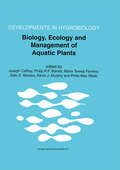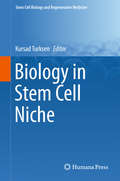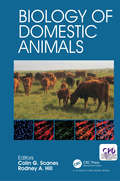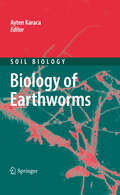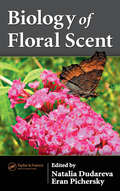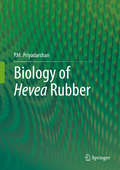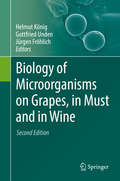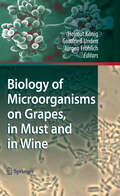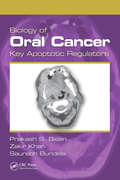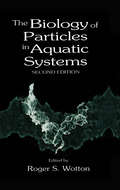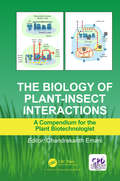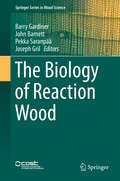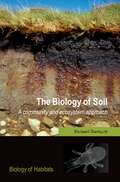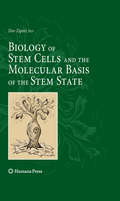- Table View
- List View
Biology, Biomimetics and Natural Design: Innovative Technologies and Sustainable Materials (Environmental Footprints and Eco-design of Products and Processes)
by Felipe Luis Palombini Amilton José Vieira de ArrudaFor billions of years, nature has provided efficient solutions to complex problems, by means of natural selection, in a harsh environment that only the fittest organisms survived. Such sustainable – still ruthless – driven evolution can be explored by designers, architects, engineers and more for the development of innovative projects. Biomimetics makes the link between Biology and Design, where features like shapes, mechanisms, colors, structures, and more can be analyzed, organized, modeled, and simulated for application in multiple creations. Therefore, such knowledge can contribute to more efficient and innovative solutions to many fields of applied science. This project aims to highlight some of the recent technological breakthroughs in Biology, Biomimetics and Natural Design that contribute to the development of sustainable and innovative materials and projects. This work consists of contributions from some of the main international groups of Biomimetics, exhibiting exciting cases of how technological advancements are leading to improved design solutions as well as shaping our very comprehension of nature and its complex organization.
Biology, Cultivation and Applications of Mushrooms
by Arun Arya Katerina RusevskaThe edited book consolidates information for profitable commercial cultivation of medicinal mushrooms. The book suggests a large number of substrates to the growers for use in commercial cultivation of Mushrooms. It also elucidates the conservation of wild endangered medicinal mushrooms. Mushrooms are the fungal fruiting bodies which can be seen by naked eyes and collected by hands. These are extremely heterogeneous organisms characterized by high levels of species diversity and are widespread in all environments. Researches conducted by score of mycologists and biotechnologists, have resulted in the continuous discovery of new species and the variability of environments where fungi can be harvested, including air, space the seabed. The fields of applications are unfolding a panorama of uses in varied fields, ranging from agriculture, bioremediation, forestry, food, cosmetics, medical, and in pharmaceutical sectors. The book comprises of three parts, first mentions their applications in Ayurvedic and traditional system of Chinese medicine for the cure of ailments. The truffles are delicious, while many others are recommended, as cure in deadly diseases like cancer, COVID-19, and HIV, as well as memory and longevity enhancer. Lentinus, Ganoderma, and Cordyceps are considered good as antioxidant and cure for inflammation. Second part deals with their occurrence in different habitats and seasons and their biology. Enzymes and mechanisms involved in biodegradation and anatomical details of rotting wood. The third part brings about the need of mushroom technology in improving rural economy. This book is a useful read for researchers and students in agriculture, agronomy and researchers working on mushrooms.
Biology, Ecology and Management of Aquatic Plants: Proceedings of the 10th International Symposium on Aquatic Weeds, European Weed Research Society (Developments in Hydrobiology #147)
by Ilidio S. Moreira Kevin J. Murphy Philip Max Wade Joseph Caffrey Philip R. F. Barrett Maria Teresa FerreiraThere is a growing need for appropriate management of aquatic plants in rivers and canals, lakes and reservoirs, and drainage channels and urban waterways. This management must be based on a sound knowledge of the ecology of freshwater plants, their distribution and the different forms of control available including chemical and physical, and biological and biomanipulation. This series of papers from over 20 different countries was generated from the tenth in the highly successful series of European Weed Research Society symposia on aquatic plant management, this being the tenth. It provides a valuable insight into the complexities involved in managing aquatic systems, discusses state-of-the-art control techniques and deals with patterns of regrowth and recovery post-management. Careful consideration is given to the use of chemicals, a practice which has come under scrutiny in recent years. Underpinning the development of such control techniques is a growing body of knowledge relating to the biology and ecology of water plants. The authorship of the papers represents the collective wisdom of leading scientists and experts from fisheries agencies, river authorities, nature conservation agencies, the agrochemical industry and both governmental and non-governmental organisations.
Biology in Stem Cell Niche: Methods And Protocols (Stem Cell Biology and Regenerative Medicine #1035)
by Kursad TurksenThis comprehensive volume explores functions, pathologies, and applications of stem cells in relation to the niches in which they develop. Ten chapters cover the subject in depth, from a historical perspective through signaling, hormonal control, quiescence, biomimetics, epigenetics, engineering strategies for emulating, tumorigenesis and more. The chapter authors represent a broad range of international expertise and perspectives.This installment of the popular Stem Cell Biology and Regenerative Medicine series delivers authoritative, international perspectives on this rapidly growing field. Biology of Stem Cell Niche is an ideal complementary volume to Tissue-Specific Stem Cell Niche and Adult Stem Cells, Second Edition and will be invaluable to clinicians and researchers working with stem cells as well as to postgraduate trainees who are studying them.
Biology of Domestic Animals
by Colin G. Scanes Rodney A. HillThere is increasing interest in the biology of domestic animals ranging from genomics, transcriptomics, metabolomics, nutritional physiology, and systems biology. This book touches on all of these, with a particular focus on topics such as domestic animals as comparative models to humans, molecular regulation of growth, metabolic efficiency, reproduction, and the impact of stress on growth and development. The book concludes with a discussion on the current and future directions for researchers.
Biology of Domestic Animals
by Colin G. Scanes Rodney A. HillThere is increasing interest in the biology of domestic animals ranging from genomics, transcriptomics, metabolomics, nutritional physiology, and systems biology. This book touches on all of these, with a particular focus on topics such as domestic animals as comparative models to humans, molecular regulation of growth, metabolic efficiency, reproduction, and the impact of stress on growth and development. The book concludes with a discussion on the current and future directions for researchers.
Biology of Earthworms (Soil Biology #24)
by Ayten KaracaEarthworms, which belong to the order Oligochaeta, comprise roughly 3,000 species grouped into five families. Earthworms have been called ‘ecosystem engineers’; much like human engineers, they change the structure of their environments. Earthworms are very versatile and are found in nearly all terrestrial ecosystems. They play an important role in forest and agricultural ecosystems. This Soil Biology volume describes the various facets of earthworms, such as their role in soil improvement, soil structure, and the biocontrol of soil-borne plant fungal diseases. Reviews discuss earthworms’ innate immune system, molecular markers to address various issues of earthworm ecology, earthworm population dynamics, and the influences of organic farming systems and tillage. Further topics include the characteristics of vermicompost, relationships between soil earthworms and enzymes, the role of spermathecae, copulatory behavior, and adjustment of the donated sperm volume.
Biology of Echinodermata
by T. YanagisawaThe proceedings of the Seventh International Echinoderm Conference, held at Atami, Japan, September 1990. In addition to sections covering ecology, evolution, reproduction, morphology, molecular biology, developmental biology, physiology, behavior, and paleontology, there are four plenary lectures a
Biology of Echinodermata
by T. YanagisawaThe proceedings of the Seventh International Echinoderm Conference, held at Atami, Japan, September 1990. In addition to sections covering ecology, evolution, reproduction, morphology, molecular biology, developmental biology, physiology, behavior, and paleontology, there are four plenary lectures a
Biology of Floral Scent
by Natalia Dudareva Eran PicherskyAs with nearly all living creatures, humans have always been attracted and intrigued by floral scents. Yet, while we have been manufacturing perfumes for at least 5000 years to serve a myriad of religious, sexual, and medicinal purposes, until very recently, the limitation of our olfactory faculty has greatly hindered our capacity to clearly and ob
Biology of Floral Scent
by Eran Pichersky Natalia DudarevaAs with nearly all living creatures, humans have always been attracted and intrigued by floral scents. Yet, while we have been manufacturing perfumes for at least 5000 years to serve a myriad of religious, sexual, and medicinal purposes, until very recently, the limitation of our olfactory faculty has greatly hindered our capacity to clearly and ob
Biology of Foodborne Parasites
by Lihua Xiao Una Ryan Yaoyu FengWhile a number of introductory books on basic and molecular biology are available, none highlight the foodborne parasitic pathogens. Until now. A state-of-the-art review, Biology of Foodborne Parasites charts significant progress and outlines key biological techniques applied to foodborne parasitic pathogens research. The book covers basic biology,
Biology of Hevea Rubber
by P. M. PriyadarshanIn the second edition of this book, the origin, upkeep and latex harvest from the Hevea rubber tree are dealt with succinctly. New chapters have been included on Propagation Systems and Genetic Resources. The importance of Heterozygosis and Breeding is a new theme for the section on Breeding. A new chapter on Genomics and Molecular Breeding that focuses on the latest advancements on gene mapping, marker assisted selection and stimulation has been added. Lastly, ‘textboxes’ that highlight points and topics of significant interest are included in the new addition.Natural rubber has been an essential commodity not only for the tire industry but also for more than 50,000 products that holds elasticity as an attribute. The prime source of natural rubber worldwide is Hevea brasiliensis. Hevea rubber tree is an excellent example of how a soil-tree-atmosphere system can work in tandem. The retrieval of rubber through ‘injuring’ the tree on alternate days or once in three days or once in seven days, is indeed a unique arrangement followed universally that ensures income to the planter almost throughout the year. Every molecule of rubber is the end result of meticulous biochemical changes. Therefore the biology of Hevea rubber tree itself is a subject that aggregates science and technology for the realization of its industrial utility.
Biology of Microorganisms on Grapes, in Must and in Wine
by Helmut König Gottfried Unden Jürgen FröhlichThe second edition of the book begins with the description of the diversity of wine-related microorganisms, followed by an outline of their primary and energy metabolism. Subsequently, important aspects of the secondary metabolism are dealt with, since these activities have an impact on wine quality and off-flavour formation. Then chapters about stimulating and inhibitory growth factors follow. This knowledge is helpful for the growth management of different microbial species. The next chapters focus on the application of the consolidated findings of molecular biology and regulation the functioning of regulatory cellular networks, leading to a better understanding of the phenotypic behaviour of the microbes in general and especially of the starter cultures as well as of stimulatory and inhibitory cell-cell interactions during wine making. In the last part of the book, a compilation of modern methods complete the understanding of microbial processes during the conversion of must to wine.This broad range of topics about the biology of the microbes involved in the vinification process could be provided in one book only because of the input of many experts from different wine-growing countries.
Biology of Microorganisms on Grapes, in Must and in Wine
by Helmut König Gottfried Unden Jürgen ÖhlichThe ancient beverage wine is the result of the fermentation of grape must. This n- urally and fairly stable product has been and is being used by many human societies as a common or enjoyable beverage, as an important means to improve the quality of drinking water in historical times, as therapeutical agent, and as a religious symbol. During the last centuries, wine has become an object of scientific interest. In this respect different periods may be observed. At first, simple observations were recorded, and subsequently, the chemical basis and the involvement of microorg- isms were elucidated. At a later stage, the scientific work led to the analysis of the many minor and trace compounds in wine, the detection and understanding of the biochemical reactions and processes, the diversity of microorganisms involved, and the range of their various activities. In recent years, the focus shifted to the genetic basis of the microorganisms and the molecular aspects of the cells, including metabolism, membrane transport, and regulation. These different stages of wine research were determined by the scientific methods that were known and available at the respective time. The recent “molecular” approach is based on the analysis of the genetic code and has led to significant results that were not even imaginable a few decades ago. This new wealth of information is being presented in the Biology of Microorganisms on Grapes, in Must, and in Wine.
Biology of Oral Cancer: Key Apoptotic Regulators
by Prakash S. Bisen Zakir Khan Saurabh BundelaDespite a decline in developed countries, cancer has consistently maintained its status as one of the top killers since time immemorial. Exploring cancer management and treatment at the molecular level, Biology of Oral Cancer: Key Apoptotic Regulators presents a key molecular event-apoptosis-in relation to genesis and progression of oral cancer. Th
The Biology of Particles in Aquatic Systems, Second Edition
by Roger S. WottonThe Biology of Particles in Aquatic Systems, Second Edition presents the latest information on particulate and dissolved matter found in aquatic habitats ranging from small streams to oceans. Only by studying this matter can we gain an understanding of the functioning of aquatic ecosystems and thus be able to predict changes that may occur as these systems become stressed. Updated and extensively revised, this new edition covers such topics as classification of particulate and dissolved matter, origin and formation of particles aquatic systems, factors affecting particle aggregation, methods for capturing particles by benthic and planktonic animals, and the use of particulate and dissolved organic matter as food.
The Biology of Particles in Aquatic Systems, Second Edition
by Roger S. WottonThe Biology of Particles in Aquatic Systems, Second Edition presents the latest information on particulate and dissolved matter found in aquatic habitats ranging from small streams to oceans. Only by studying this matter can we gain an understanding of the functioning of aquatic ecosystems and thus be able to predict changes that may occur as these systems become stressed. Updated and extensively revised, this new edition covers such topics as classification of particulate and dissolved matter, origin and formation of particles aquatic systems, factors affecting particle aggregation, methods for capturing particles by benthic and planktonic animals, and the use of particulate and dissolved organic matter as food.
The Biology of Plant-Insect Interactions: A Compendium for the Plant Biotechnologist
by Chandrakanth EmaniOverviews of biochemical, genetic, and molecular perspectives of plant-insect interactions with added emphasis on bioinformatic, genomic, and transcriptome analysis are comprehensively treated in this book. It presents the agro-ecological and evolutionary aspects of plant-insect interactions with an exclusive focus on the climate change effect on the resetting of plant-insect interactions. A valuable resource for biotechnologists, entomologists, agricultural scientists, and policymakers, the book includes theoretical aspects as a base toward real-world applications of holistic integrated pest management in agro-ecosystems.
The Biology of Plant-Insect Interactions: A Compendium for the Plant Biotechnologist
by Chandrakanth EmaniOverviews of biochemical, genetic, and molecular perspectives of plant-insect interactions with added emphasis on bioinformatic, genomic, and transcriptome analysis are comprehensively treated in this book. It presents the agro-ecological and evolutionary aspects of plant-insect interactions with an exclusive focus on the climate change effect on the resetting of plant-insect interactions. A valuable resource for biotechnologists, entomologists, agricultural scientists, and policymakers, the book includes theoretical aspects as a base toward real-world applications of holistic integrated pest management in agro-ecosystems.
The Biology of Reaction Wood (Springer Series in Wood Science #Vol. 31)
by Barry Gardiner John Barnett Pekka Saranpää Joseph GrilThe book is a fundamental reference source on reaction wood for wood scientists and technologists, plant biologists, silviculturists, forest ecologists, and anyone involved in the growing of trees and the processing of wood. It brings together our current understanding of all aspects of reaction wood, and is the first book to discuss both compression wood and tension wood.Trees produce reaction wood to maintain the vertical orientation of their stems and the optimum angle of each branch. They achieve this by laying down fibre cell walls in which differences in physical and chemical structure from those of normal fibres are expressed as differential stresses across the stem or branch. This process, while of obvious value for the survival of the tree, causes serious problems for the utilisation of timber. Timber derived from trees containing significant amounts of reaction wood is subject to dimensional instability on drying, causing twisting, bending and splitting. It is also difficult to work as timber, and for the pulp and paper industry the cost of removing the increased amount of lignin in compression wood is substantial. This has both practical and economic consequences for industry.Understanding the factors controlling reaction wood formation and its effect on wood structure is therefore fundamental to our understanding of the adaptation of trees to their environment and to the sustainable use of wood.The topics covered include:-Morphology, anatomy and ultrastructure of reaction wood-Cell-wall polymers in reaction wood and their biosynthesis-Changes in tree proteomes during reaction wood formation-The biomechanical action and biological functions of reaction wood- Physical and mechanical properties of reaction wood from the scale of cell walls to planks-The detection and characterisation of compression wood-Effects of reaction wood on the performance of wood and wood-based products- Commercial implications of reaction wood and the influence of forest management on its formation
Biology of Root Formation and Development (Basic Life Sciences #65)
by Arie Altman Yoav WaiselThis book contains the majority of the presentations of the Second International Symposium on the Biology of Root Formation and Development that was hcld in Jerusa lem, Israel, June 23---28, 1996. Following the First Symposium on the Biology of Adventi tious Root Formation, held in Dallas. USA, 1993, we perceived the need to include all kinds of roots, not only the shoot-borne ones. The endogenous signals that control root formation. and the subsequent growth and development processes, are very much alike, re gardless of the sites and sources of origin of the roots. Therefore, we included in the Sec ond Symposium contributions on both shoot-borne (i.e., adventitious) roots and root-borne (i.e., lateral) roots. Plant roots have remained an exciting and an intriguing field of sciencc. During thc years that followed the first symposium, an exceptional proliferation of interest in root biology has developed, associated with the intensive research activity in this field and the contemporary developments in the understanding of root function and development. New methods have been applied, and old ideas and interprctations werc rccxamined. Alto gether, it became necessary to update our viewpoints and to expand them.
The Biology of Soil: A community and ecosystem approach (Biology of Habitats)
by Richard BardgettThis book is unique in providing a comprehensive, up-to-date synthesis of what is known about soil biodiversity and the factors that regulate its distribution, as well as the functional significance of below-ground biodiversity for ecosystem form and function. It describes the vast diversity of biota that live in the soil environment - the most complex habitat on Earth - and discusses the factors that act as determinants of this diversity across different spatial and temporal scales. The Biology of Soil also considers how biotic interactions in soil influence the important soil processes of decomposition and nutrient cycling . It demonstrates how interactions and feedbacks between diverse plant and soil communities act as important drivers of ecosystem form and function. The importance of these relationships for understanding how ecosystems respond to global change phenomena, including climate change, is discussed in depth. Much is still to be learned about the soil biota and their roles in ecosystems, and the author highlights some of the many challenges that face ecologists in the exploration of soil. Richard Bardgett has wide experience in soil and terrestrial ecology, and his background of research in many ecosystems is reflected in this book which is the most comprehensive, up-to-date volume currently available in soil ecology. It provides an introduction to the biology of soil, and it also discusses the most recent developments in this progressive field of ecology. The importance of soil biotic interactions for community and ecosystem ecology is illustrated through the use of numerous examples and case studies. The Biology of Soil provides an excellent, easy to read introduction for anyone working in the field of soil ecology and related disciplines, and will be ideal for students taking undergraduate and postgraduate courses in soil ecology, plant-soil relationships, ecosystem ecology, and land management.
Biology of Stem Cells and the Molecular Basis of the Stem State (Stem Cell Biology and Regenerative Medicine)
by Dov ZiporiBiology of Stem Cells and the Molecular Basis of the Stem State concentrates upon adult stem cells, particularly on mesenchymal cell populations, which is the author’s area of expertise. The text offers the reader a detailed description of the emergence of stem cell research and the dogmas that were created during the first decades of analysis of stem cell properties, particularly those of hemopoietic stem cells. Biology of Stem Cells and the Molecular Basis of the Stem State also introduces the reader to the commonly accepted notions regarding stem cell biology, with an emphasis on an alternative view of stemness, i.e. the stem state. In keeping with the popularity of this topic, Biology of Stem Cells and the Molecular Basis of the Stem State addresses the major controversies and points of dispute, among researchers in the stem cell field. Overall, Biology of Stem Cells and the Molecular Basis of the Stem State presents a well-rounded dialogue about stem cells as it not only concentrates upon the biological elements of stem cell, but also addresses the controversy and hype currently enveloping this popular subject.
Biology of the Fungal Cell (The Mycota #8)
by Richard J. Howard Neil A. R. GowWhat makes the fungal cell unique among eukaryotes and what features are shared? This volume addresses some of the most persistent and fascinating questions as they pertain to the growth and development of both yeast and hyphal forms of fungi. Beginning with subcellular components, the book moves on to topics including cell organization and polarity. It then moves beyond these matters to examine the cell biology of spores, the biomechanics of invasive growth, and many other subjects.


